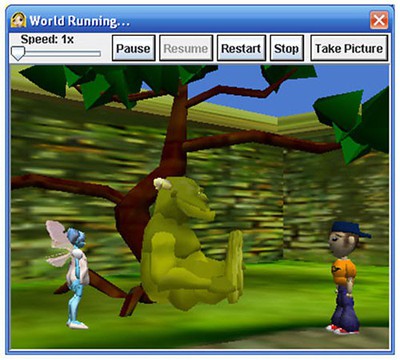Abstract
The Incredibles, Ratatouille, Up. What do these Pixar films have in common? They are all computer-animated films. While the writers and directors came up with the compelling stories and the kinds of scenes that would best tell the stories, the computer animation experts brought the films to life. In this computer science project, you will easily be able to create your own animated story using a simple computer programming environment called Storytelling Alice. To create your animation, you will simply drag and drop different instructions on the computer screen—while you will learn programming basics, there is no special computer language to learn. Start your storytelling right away, and you'll have a cool computer science project in no time!Summary
Michelle Maranowski, PhD, Science Buddies

Objective
To use Carnegie Mellon's 3-D programming environment, Storytelling Alice, to animate an existing fable or your own made-up story.
Introduction
Cell phones, laptops, texting, iPods, and iPads are all examples of recent technologies that have allowed us to stay connected to each other. It's fun to stay in contact with your friends and family and share details about your day, but did you know that there is a lot of computer science behind all of these devices? Computer science is what makes these devices work individually, and sometimes together. We'll be discussing more about the fun in computer science in a minute, but first, let's get a few key definitions out of the way!
Computer science includes the study of the instructions, or algorithms, that support how information is received, processed, and stored. Information can mean anything from ringtones to texts to e-mails. There are many sub-areas of study in the computer science field, such as computer programming and computer graphics. Computer programming is the science of writing and testing algorithms and computer graphics is the science of using and manipulating algorithms to create visual images. So the computer animators who create movies (a series of moving, animated images) like Up, Ratatouille, and The Incredibles, are computer scientists because they work with algorithms (instructions) that generate moving, visual images.
Computer animation is a really fun example of how to apply computer science. You have the logic and the science of creating the many algorithms required to animate characters, plus the end product of the animation or movie, which you can share with your friends and family. In this computer science project, you will become an animator and use a 3-D programming environment called Storytelling Alice (from Carnegie Mellon University) to make an animation of an existing fable or your own made-up story. While the words 3-D programming environment might sound a little intimidating, it really isn't! If you can use your mouse to drag and drop objects on the computer screen, you can create a computer program to animate characters on the screen. Let your creative juices flow and start animating!
 Image Credit: Carnegie Mellon University / Free to public
Image Credit: Carnegie Mellon University / Free to public
Figure 1. This animation, done in Storytelling Alice, tells the tale of a trouble-making fairy, an ogre, and an unsuspecting human named Trevor. You can run this animation yourself in Storytelling Alice's second tutorial.
Terms and Concepts
- Computer science
- Algorithm
- Computer programming
- Computer graphics
- Computer animation
- Interface
- Flow chart
Questions
- What is computer science?
- What is a computer program?
- What are computer graphics?
- What is computer animation?
Bibliography
- Wikipedia Contributors. (2010, March 14). Computer science. Wikipedia: The Free Encyclopedia. Retrieved March 16, 2010.
- Wikipedia Contributors. (2010, March 13). Computer graphics. Wikipedia: The Free Encyclopedia. Retrieved March 16, 2010.
Materials and Equipment
- Windows-based computer with an Internet connection, as well as permission and room to download the Storytelling Alice program
- Adult helper
Experimental Procedure
Creating Your Animation in Storytelling Alice
- The first step is to download Storytelling Alice and become familiar with it. For step-by-step instructions on how to do this, refer to the Science Buddies page How to Get Started Downloading and Using Storytelling Alice. Go through the tutorials and the examples.
- If you want to see an example of a Storytelling Alice animation, you can download the Big Bad Wolf demonstration. Save it to your personal computer, and open the file in Storytelling Alice. Now you're ready to start on your own animation!
- Define a need. First, decide who your audience is and what kind of story they would like to see.
- Specify the requirements of your story. Your story can be about anything that you want, but to make this a strong engineering project that emphasizes your programming skills, you should follow the suggestions below. For more explanation on some of these constructs (like "Method," "Do Together," and "Loop"), refer back to the Science Buddies page How to Get Started Downloading and Using Storytelling Alice.
- The story needs to make sense and should be at least 2 minutes long.
- You must switch scenes at least twice. If you need help learning how to switch scenes, refer to the multiple scenes example in Storytelling Alice.
- You must make a new method for each character in your story. For example, you could get each character to do a dance, like the cha-cha when they are happy. If you need help learning how to make a method, refer to tutorial #2 (with Trevor and the Ogre).
- The objects in your story should interact with each other, like in reality. You can accomplish this using a Do Together construct. Have your character or scenery objects interact at least once in each scene.
- In each scene, you should use the loop construct to have one or more characters or scenery objects perform a task repeatedly.
- Create and analyze designs. Keeping the above list of requirements in mind make a rough sketch, flow chart, or plan of what your animation will look like and what the characters will do and say. Look at different ways of changing scenes and select the best way.
- Build a starter or test program. Start your program with a small step. Choose an object from the galleries and have it execute a method or a set of methods. Is Storytelling Alice performing properly? Are you happy with the way the program executed? If everything looks good, then continue programming. If not, then fix any problems now. If you need help troubleshooting, read the next section about troubleshooting.
- Program your animation.
- It is a good idea to test your project as you create it. Simply run the program each time you have something new occur.
- If you decide you don't like the story flow or how the characters look feel free to go back and re-design.
- Test and redesign. When you are finished, share your animation with your target audience. How did they like it? Can you use their feedback to improve it?
Troubleshooting Your Animation in Storytelling Alice
- What should you do when you get an error while playing your animation?
- Don't panic or get frustrated. Learning takes time and there are a lot of Storytelling Alice Help menus available to help you work through the error to get your story just the way you want it.
- Is this the first time you have run the animation?
- If this is the first time you have run the animation, start by taking out all of the method calls, loops, and other constructs, except for the first one. Write down on a sheet of paper all of the method calls or print it out so that you have a record of what you wrote. Then delete all but the first method call or construct from the editing area. Run Storytelling Alice with just one method call or construct to make sure that it is working properly. Then add the next method call or construct in and run Storytelling Alice to make it is working properly. Continue to do this until you find the problematic line.
- Or are you running an animation that was previously working?
- If you recently added method calls or constructs to an animation that was working, simply take out the new method calls or constructs and add them back in one at a time, as in step 1.b.
The Final Product
- Once you have finished your animation and you are happy with it, it is time to show it to your friends and family!
- When presenting your animation work at your science fair, try to bring in a computer. If you are not able to do so, then take many screenshots of your work.
- Your science fair presentation should also include:
- The requirements list that guided your animation.
- A flow chart of how your animation program works, which is a diagram of boxes where each box is a step in the program you wrote.
- An explanation of what you learned from your research and from doing the animation.
- For more information about presenting your Storytelling Alice animation for a science fair, consult the Engineering Design Project Guide.
Ask an Expert
Global Connections
The United Nations Sustainable Development Goals (UNSDGs) are a blueprint to achieve a better and more sustainable future for all.
Variations
- Learn more about conditional statements, such as the "If/Else" construct. This construct will execute a method or a set of methods based on whether a condition is true. If the condition is false, then a different method, set of methods, or nothing will execute. Experiment with the If/Else construct and use it within your animation.
- Have the viewer interact with your animation by creating button-click events in the Event area. Remember, you can learn how to use the Event area by reading through the examples in Storytelling Alice.
- Make a more complicated animation using Carnegie Mellon University's Alice programming environment. Watch the Alice tour to get an idea of how to get started. You can download Alice from this Carnegie Mellon's website, Alice.
Careers
If you like this project, you might enjoy exploring these related careers:
Related Links
- Science Fair Project Guide
- Other Ideas Like This
- Computer Science Project Ideas
- Video & Computer Games Project Ideas
- My Favorites
- Engineering Design Project Guide
- How to Get Started Downloading and Using Storytelling Alice










